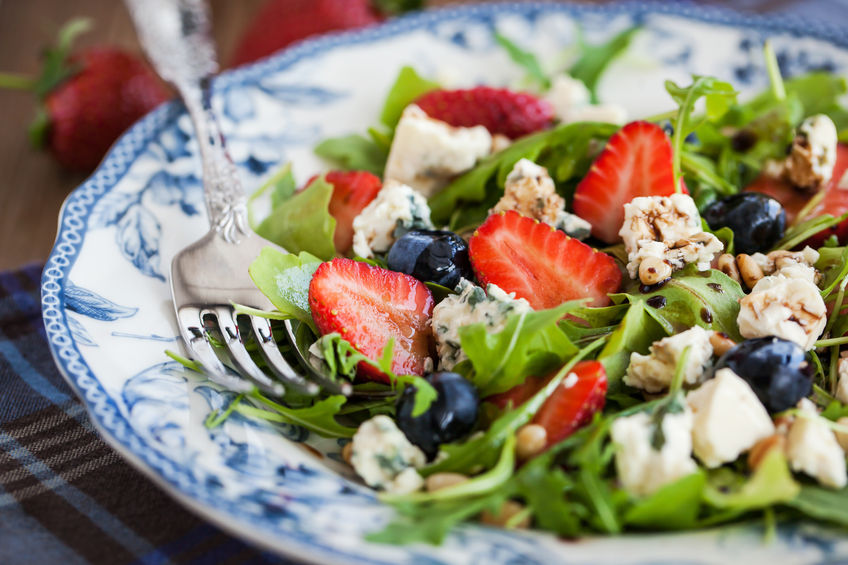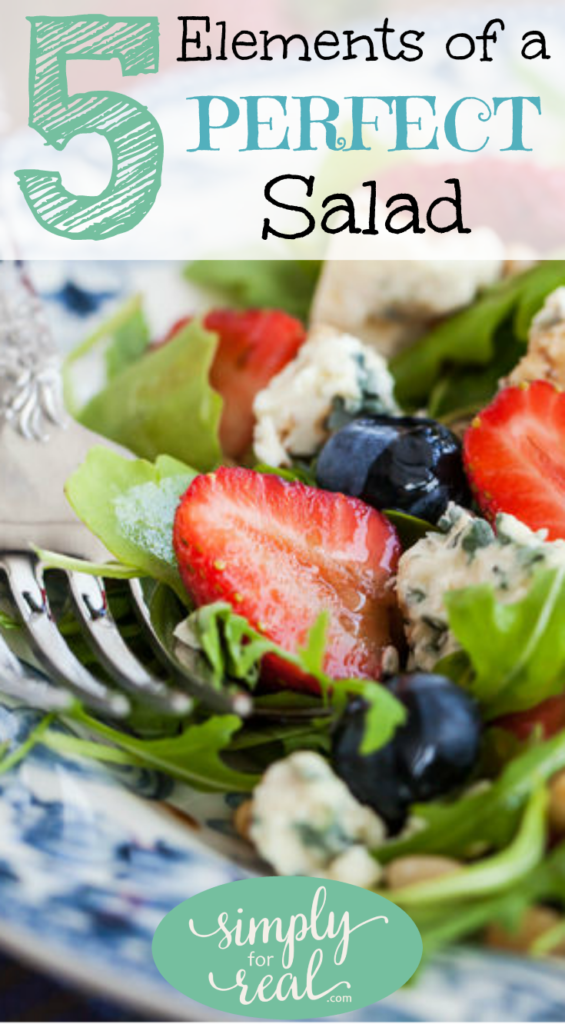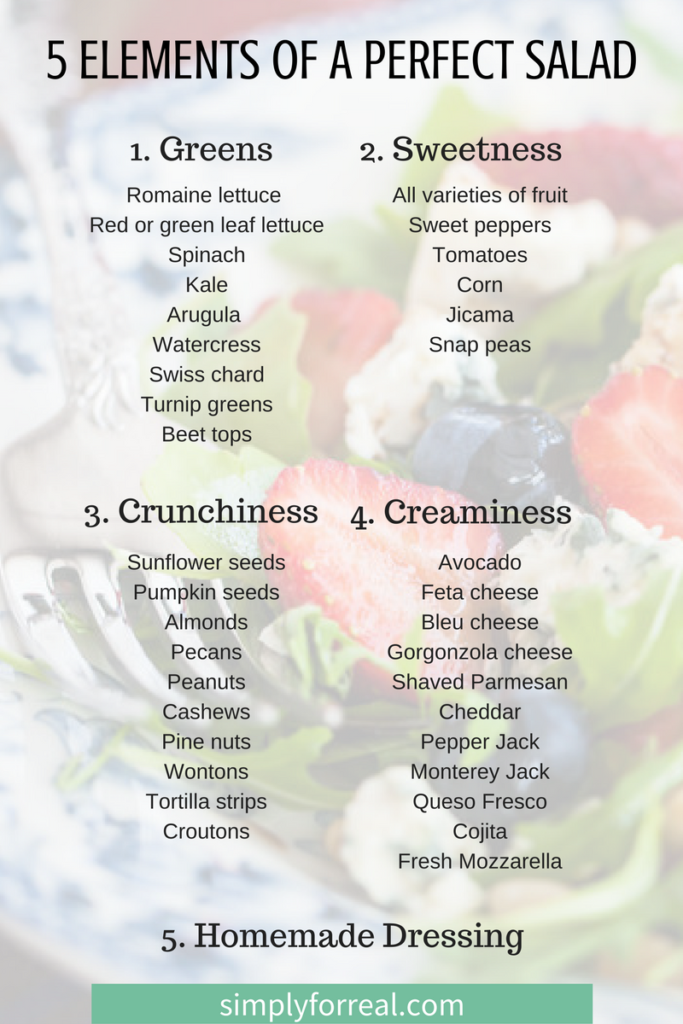
I like to think of myself as a caring, loving, accepting person who does not get riled up about too many things. But sometimes I am a snob.
Most of my snobbery revolves around food. Like butter, for instance. I avoid margarine like the plague. And let’s not even talk about premade packets of my favorite winter beverage, hot chocolate. They are, indeed, a sorry excuse for the real thing.
I could ramble on for hours about butter and chocolate, but I will spare you the monologue. For now, let’s talk about the thing that arguably tops my list of snobbishness: salad.
I grew up in a home where salad was an afterthought. When a bowl of greens did make it onto the table, it was always the same: iceberg lettuce, a few tomatoes, and maybe a sliced carrot or cucumber. Bottles of Ranch, Italian, and Thousand Island dressing sat nearby, waiting for their turn to shine. But nobody ate much salad because, well, it was quite boring.
I don’t remember when a light bulb went on in my head and I realized that salad could be a delicious masterpiece if prepared correctly. It was, indeed, a life-altering revelation to learn that simple homemade dressing combined with a variety of textures and flavors can turn a bland, little-touched side dish into a scrumptious meal.
Now I crave salad. I see it is an art form, one that can be as versatile and flexible as I want it to be. It is one of my favorite things to bring to potlucks and people often ask me for the recipe after those events. Usually, I don’t follow a recipe. I may use one for inspiration, but I have learned to mix ingredients together in a way that creates a party in my mouth.
I will share some specific salad recipes in the coming days and weeks. But today, I am going to teach you how to make a salad without using a recipe so you, too, can become a salad artist. Sound like a deal?

There are five elements to a perfect salad: greens, sweetness, creaminess, crunchiness, and dressing. Let’s talk about each one.
1. GREENS
There are undoubtedly salads that do not include greens, but we will talk about those another day. Greens are an integral part of most vegetable salads. When choosing what greens to include, do not limit yourself to iceberg lettuce, or any other type of lettuce, for that matter.
As a general rule, in the realm of green leafy vegetables, darker colors means higher nutritional content. Consequently, iceberg lettuce has little nutritional value in comparison to other varieties. There are plenty of other greens to experiment with, all with slightly different flavor profiles. My advice is to mix it up and try something new.
Here are just a few options:
- Romaine lettuce (the most nutrient dense lettuce)
- Red or green leaf lettuce
- Spinach
- Kale
- Arugula (has a slightly spicy flavor)
- Watercress
- Swiss chard
- Turnip greens
- Beet tops
The greens at the top of the list are more mild in flavor. Start with those if you are not used to eating a variety of greens, and add in small amounts of the others on the list until you are used to their stronger flavors. You certainly don’t have to make an entire salad of Swiss chard, beet tops or turnip greens (and I wouldn’t recommend it), but they do add a dense flavor and are delicious as part of a mixed salad.
Any greens with the word “baby” in front of them (baby spinach, baby kale, etc.) have a milder flavor than their mature counterparts. If you are not used to the bitter taste of some greens, try the baby varieties first. Also, greens with a firmer texture like cabbage and kale are awesome for salads because you can pour dressing on them and they stay good for a couple of days in the fridge, rather than getting soggy like more delicate varieties.
2. SWEETNESS
I am a big believer in adding a little sweetness to almost every salad. Even savory combinations benefit from a hint of sugar. I am not a fan of highly sweetened dressings, however. Too much sugar in the dressing drowns out the flavors in the salad itself and ruins the overall experience. But we will get to dressings in a minute.
In my opinion, the best way to add sweetness to a salad is with fruit. I almost always add fruit to my salads, be it fresh, dried, or canned. In some cases, fruit does not fit the flavor profile I am trying to achieve. In those scenarios, I try to include a vegetable with a higher sugar content, such as sweet peppers, snap peas, cherry or grape tomatoes, corn, or jicama. They bump up the sweetness factor just enough to satisfy my sweet tooth.
3. CRUNCHINESS
This is where the party happens, friends. A salad is bland and boring without some crunch. You obviously get a little bit of crunch from the greens, but it should not stop there. Add some crunchy veggies and/or fruit, such as carrots, apples, cucumbers, jicama, broccoli, cauliflower, etc. Use whatever sounds good.
But don’t stop there, either. The best salads are finished with additional crunch from seeds, nuts (candied nuts also add sweetness), wontons, tortilla strips, croutons, or any other crunchy item that is not a fruit or vegetable. Be creative and use what you have on hand.
4. CREAMINESS
Creaminess makes my world go round, and salads are not exempt from its heavenly clutches. I do not pour cream on my salads, although that might be delicious. But I do add a touch of creaminess in other ways because the smooth texture is delightful in contrast to the crunchiness that we already discussed.
Most of the time, cheese is my creamy salad topping of choice. Feta, bleu, and gorgonzola are good if you want to add a bit of a kick. I used to hate all three of them, but salads have convinced me of their amazingness. I do think you should give them a fair chance. But, if they are not your cup of tea, try these milder varieties:
- Shaved or grated parmesan
- Fresh mozzarella
- Queso Fresco
- Cojita
- Cubed or shredded cheddar, Monterey jack, pepper jack, Colby, etc.
If you are not a fan of cheese, you can add avocado to your salad for creaminess. Or, you could make a creamy dressing to top it off. That leads us to the final, and perhaps most important element of an amazing salad: dressing.
5. DRESSING
This is the component that changed my mind about salad. Dressing will undoubtedly make or break a salad. Period. If you have all of the elements of a stellar salad and dress it with a bottle of cheap Italian or ranch dressing, it will taste cheap.
Homemade dressings can transform a mediocre salad into something spectacular. And guess what? They are SO easy to make. It takes less than five minutes to make a delicious dressing with ingredients that are most likely already in your pantry and fridge.
Most of the dressings that I make are simple combinations of different types of vinegars (rice vinegar, red wine vinegar, white wine vinegar, apple cider vinegar, balsamic vinegar) and oil (olive oil, canola oil, avocado oil), mixed with different herbs and spices and sometimes a touch of honey or sugar. They are simple, wholesome, and delicious.
Once again, I would recommend that you watch the sweetness level of the dressing. Many recipes that I have come across call for loads of sugar, which I don’t personally care for. I usually cut WAY back on the sugar to let the flavors from the fruits and veggies shine through.
That is one of the benefits of making your own dressing: you get to control what is in it. Let me warn you, though, that once you start down the road of homemade dressing, you will never go back. And your salads will be forever grateful.
Since I am just starting out on the recipe path, head on over to one of my favorite food blogs, Our Best Bites, and check out their recipes for homemade salad dressings. They have quite a selection and you are sure to find a few that suit your taste buds. (Plus, they have tons of other awesome recipes as well.)
OTHER THINGS TO CONSIDER
- I do not add protein to every salad, but it does help to bump it from a side dish to a meal. You can experiment with chicken, steak, pork, fish, and different varieties of beans and lentils.
- I also like to add grain from time to time, depending on the salad. Quinoa is excellent (especially with kale…recipe coming soon), along with couscous, rice, farro and different varieties of pasta.
It does take a little while to learn which flavor combinations taste good together. It calls for some experimentation, which is the fun part. If you have no idea where to start, look at what is in season in your area. Not only will be it be fresh and delicious, but you will also probably find a host of things whose flavors blend well.
You can also pull flavor profiles from different cuisines. Here are a few examples:
CHINESE
soy sauce, ginger, garlic, cilantro, scallions, sesame, sriracha, cabbage, mandarin oranges, snap (and snow) peas, green beans, peppers, edamame, rice.
MEXICAN
cilantro, cumin, garlic, onion, jalepeño, tomato, peppers, corn, black and pinto beans, lime, rice, sour cream, salsa
ITALIAN
basil, oregano, parsley, rosemary, thyme, tomatoes, parmesan and romano cheese, pasta, olive oil, artichokes, white beans, prosciutto
GREEK/MEDITERRANEAN
garlic, onion, mint, basil, rosemary, dill, parsley, cucumber, tomato, olives, olive oil, figs, raisins, honey, citrus, tahini, yogurt
FRENCH
soft cheeses, Dijon mustard, mirepoix (onions, celery, carrots), bouquet garni (thyme, parsley, bay leaf, peppercorn), capers, wine vinegar, leeks, mushrooms, cream
At the end of the day, salad can be whatever you want it to be, which is why I love it so much. There are no rules to this game, only personal preferences. Be sure to start with a variety of greens and add sweetness, crunchiness, creaminess, and homemade dressing, and your creation is sure to keep people coming back for more.



I love salads and could easily eat them every day. My friend and I used to joke that we should have salad potlucks. Now that would be heaven, a table of different salads. I agree with you. Homemade salad dressings are so much better than store bought. Great article.
A salad potluck sounds like an amazing idea! Maybe I will host one…
Have you ever read the book “Kitchen counter Cooking school?” Also “French Kids eat everything” Both really great books. I think you would like both of them, I found them at my local library. Did you know ounce per ounce salad dressing is one of the most expensive items at the grocery store? I love salads, and these are awesome ideas on how to mix it up! Thanks for sharing.
I haven’t read either of those books, but you are the second person within a couple of weeks to recommend “French Kids Eat Everything.” I will have to read them both. That is so interesting that salad dressing is one of the most expensive items at the grocery store. It is so easy and cheap to make at home.